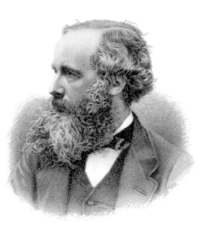Difference between revisions of "Lecture 1."
(→Maxwell's Equations) |
(→Integral Form) |
||
| Line 76: | Line 76: | ||
|- valign=top | |- valign=top | ||
| width=40%, style="text-align: right;" | | | width=40%, style="text-align: right;" | | ||
| − | <math>\oint_{\scriptstyle l}\vec{H}(\vec{r},t)\cdot\text{d}\vec{l}=\ | + | <math>\oint_{\scriptstyle l}\vec{H}(\vec{r},t)\cdot\text{d}\vec{l}=\int_{\scriptstyle A}\vec{J}(\vec{r},t)\cdot\text{d}\vec{A}+\frac{\partial}{\partial t}\int_{A}\vec{D}(\vec{r},t)\cdot\text{d}\vec{A}</math> |
| width=20%, style="text-align: left;" | | | width=20%, style="text-align: left;" | | ||
Ampere's law, | Ampere's law, | ||
| Line 82: | Line 82: | ||
|- valign=top, | |- valign=top, | ||
| width=40%, style="text-align: right;" | | | width=40%, style="text-align: right;" | | ||
| − | <math>\oint_{l}\vec{E}(\vec{r},t)\cdot\text{d}\vec{l}=-\frac{\partial}{\partial t}\ | + | <math>\oint_{l}\vec{E}(\vec{r},t)\cdot\text{d}\vec{l}=-\frac{\partial}{\partial t}\int_{A}\vec{B}(\vec{r},t)\cdot\text{d}\vec{A}</math> |
| width=20%, style="text-align: left;" | | | width=20%, style="text-align: left;" | | ||
Faraday's law, | Faraday's law, | ||
|- valign=top | |- valign=top | ||
| width=40%, style="text-align: right;" | | | width=40%, style="text-align: right;" | | ||
| − | <math>\ | + | <math>\oint_{\scriptstyle A}\vec{B}(\vec{r},t)\cdot\text{d}\vec{A}=0</math> |
| width=20%, style="text-align: left;" | | | width=20%, style="text-align: left;" | | ||
Gauss's law (magnetic), | Gauss's law (magnetic), | ||
|- valign=top | |- valign=top | ||
| width=40%, style="text-align: right;" | | | width=40%, style="text-align: right;" | | ||
| − | <math>\ | + | <math>\oint_{\scriptstyle A}\vec{D}(\vec{r},t)\cdot\text{d}\vec{A} = \int_{\scriptstyle V}\rho(\vec{r},t)\text{d}V</math> |
| width=20%, style="text-align: left;" | | | width=20%, style="text-align: left;" | | ||
Gauss's law (electric). | Gauss's law (electric). | ||
Revision as of 08:06, 25 February 2019
|
Instructor
|
Teaching Assistants:
|
Contents
Basic Principle of Electromagnetic Theory
Electromagnetic theory forms the foundation of different physical fields and phenomenon. It is used to explain many wave phenomena like propagation, reflection, refraction, diffraction and scattering. In the following, we shall review the fundamental aspects of the electromagnetic theory.
Maxwell's Equations
The physics of electromagnetic field is described mathematically by the Maxwell's equations. These equations can be written in differential as well as integral forms. For time-varying electromagnetic fields, the Maxwell's equations are as follows.
Differential Form
[math]\nabla\times\vec{H}(\vec{r},t)=\vec{J}(\vec{r},t)+\frac{\partial D(\vec{r},t)}{\partial t}[/math]
Ampere's law,
[math]\nabla\times\vec{E}(\vec{r},t)=-\frac{\partial \vec{B}(\vec{r},t)}{\partial t}[/math]
Faraday's law,
[math]\nabla\cdot\vec{B}(\vec{r},t)=0[/math]
Gauss's law (magnetic),
[math]\nabla\cdot\vec{D}(\vec{r},t)=\rho(\vec{r},t)[/math]
Gauss's law (electric),
where:
- [math]\vec{H}(\vec{r},t)[/math] is magnetic field intensity in [A/m];
- [math]\vec{E}(\vec{r},t)[/math] is electric field intensity in [V/m];
- [math]\vec{B}(\vec{r},t)[/math] is magnetic flux density in [Wb/m[math]^2[/math]];
- [math]\vec{D}(\vec{r},t)[/math] is electric flux density in [C/m[math]^2[/math]];
- [math]\vec{J}(\vec{r},t)[/math] is electric current density in [A/m[math]^2[/math]];
- [math]\rho(\vec{r},t)[/math] is electric charge density in [C/m[math]^3[/math]].
The field quantities are depending on space [math]\vec{r}[/math] and on time [math]t[/math], therefore in the following a shorter notation will be left.
There is an important relationship between the variation of the current density [math]\vec{J}[/math] and the charge density [math]\rho[/math], the so-called current continuity equation (also called charge conservation law). This law is coming from the divergence of first Maxwell’s equation:
[math]\nabla\cdot(\nabla\times\vec{H})=\nabla\cdot\biggl(\vec{J}+\frac{\partial D}{\partial t}\biggr)=\nabla\cdot\vec{J}+\frac{\partial}{\partial t}\nabla\cdot\vec{D}[/math].
The left-hand side is equal to zero according to the identity [math]\nabla\cdot(\nabla\times\vec{v})\equiv 0[/math], for any vector [math]\vec{v}=\vec{v}(\vec{r},t)[/math] and the second term on the right-hand side can be rewritten by applying electric Gauss's law. Finally the current continuity equation has the form
[math]\nabla\cdot\vec{J}+\frac{\partial \rho}{\partial t} = 0[/math].
This equation means that the variation of current and charge distribution according to space and time is dependent on each other.
Integral Form
The integral form of Maxwell's equations can be derived from their differential form by employing Stoke's theorem and Gauss's theorem. The integral form is given by
[math]\oint_{\scriptstyle l}\vec{H}(\vec{r},t)\cdot\text{d}\vec{l}=\int_{\scriptstyle A}\vec{J}(\vec{r},t)\cdot\text{d}\vec{A}+\frac{\partial}{\partial t}\int_{A}\vec{D}(\vec{r},t)\cdot\text{d}\vec{A}[/math]
Ampere's law,
[math]\oint_{l}\vec{E}(\vec{r},t)\cdot\text{d}\vec{l}=-\frac{\partial}{\partial t}\int_{A}\vec{B}(\vec{r},t)\cdot\text{d}\vec{A}[/math]
Faraday's law,
[math]\oint_{\scriptstyle A}\vec{B}(\vec{r},t)\cdot\text{d}\vec{A}=0[/math]
Gauss's law (magnetic),
[math]\oint_{\scriptstyle A}\vec{D}(\vec{r},t)\cdot\text{d}\vec{A} = \int_{\scriptstyle V}\rho(\vec{r},t)\text{d}V[/math]
Gauss's law (electric).
The Maxwell's equations are general and hold for fields with arbitrary time dependence in any medium and at any location.
